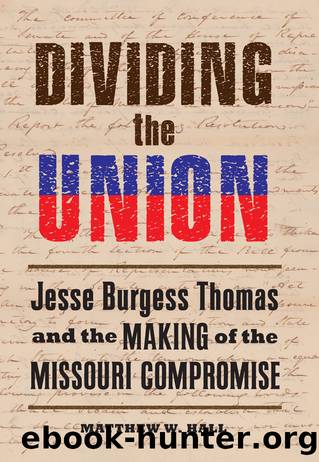Dividing the Union by Hall Matthew W.;

Author:Hall, Matthew W.; [Hall, Matthew W.]
Language: eng
Format: epub
Publisher: Southern Illinois University Press
CHAPTER 10
Maneuvering for Position
At the close of the Fifteenth Congress in the spring of 1819, the country at large, with the exception of Missouri and Illinois, did not feel the same intensity about Missouri as did the ardent partisans in Congress. In fact, that spring and early summer, ordinary citizens on the Eastern Seaboard were more concerned about the gathering financial panic and the declining state of the economy. There were, however, two centers of activity in the East that were to affect the landscape when the Missouri debate resumed in the fall. The first was in Massachusetts, where early that summer the Federalist legislature passed an act by which the predominantly Republican district of Maine, up until then a part of Massachusetts, could become a separate state, thus putting another potential state into play in the negotiations that ensued. Because of congressional dawdling on prior attempts at separation, the act stipulated that Maine must obtain the approval of the U.S. Congress by March 4 of the following year, a deadline that proved later to be critically important in the Missouri controversy.
The other locus of activity during that summer was the middle states of Pennsylvania, New Jersey, and New York, where antislavery emotion concerning Missouri was starting to build. Elias Boudinot, a philanthropist and a Federalist, presided over the first large antislavery gathering, held in Burlington County, New Jersey, on August 30. This marked the beginning of a resurgence of Federalist leadership in the antislavery cause. The Burlington meetings were followed by mass gatherings in New York City, where followers of DeWitt Clinton joined Federalists in the crusade. The involvement of Federalists, Clintonians, and others gave rise to the conviction among Southern Republicans, and particularly President Monroe, that the entire effort was being organized not so much to stop the spread of slavery as to split the Republican Party into Southern and Northern wings, with the Federalists positioning themselves to absorb the latter. The success of the Federalists in the fall elections lent credence to Monroeâs fears, though, as shall be seen, there is also evidence that Monroe and the proslavery moderates used the bugbear of a Federalist plot to good effect to gain the grudging support of a few key Southern moderates and the ultimate acquiescence of many Southern radicals. It was ironic, but essential to the Union, that at least some Southerners proved in the end to be more worried about Federalists than they were about the principle of unrestricted slavery in the West.1
When the Sixteenth Congress convened on December 6, slavery on the frontier was once again in the forefront, even as more practical-minded legislators pushed Congress to turn its attention to the deepening economic crisis. The slavery issue first arose when the proposed constitution of the state of Alabama was presented on December 8, initially in the Senate and then in the House. The Senate passed the joint resolution in perfunctory fashion and rushed it over to the House, where some antislavery members tried to delay consideration.
Download
This site does not store any files on its server. We only index and link to content provided by other sites. Please contact the content providers to delete copyright contents if any and email us, we'll remove relevant links or contents immediately.
Hit Refresh by Satya Nadella(8344)
When Breath Becomes Air by Paul Kalanithi(7273)
The Girl Without a Voice by Casey Watson(7271)
Do No Harm Stories of Life, Death and Brain Surgery by Henry Marsh(6342)
A Court of Wings and Ruin by Sarah J. Maas(6110)
Hunger by Roxane Gay(4232)
Shoe Dog by Phil Knight(4181)
Everything Happens for a Reason by Kate Bowler(4075)
A Higher Loyalty: Truth, Lies, and Leadership by James Comey(4039)
The Rules Do Not Apply by Ariel Levy(3913)
Tuesdays with Morrie by Mitch Albom(3839)
The Immortal Life of Henrietta Lacks by Rebecca Skloot(3833)
How to Change Your Mind by Michael Pollan(3686)
Millionaire: The Philanderer, Gambler, and Duelist Who Invented Modern Finance by Janet Gleeson(3575)
All Creatures Great and Small by James Herriot(3526)
Elon Musk by Ashlee Vance(3460)
Tokyo Vice: An American Reporter on the Police Beat in Japan by Jake Adelstein(3441)
Man and His Symbols by Carl Gustav Jung(3325)
The Money Culture by Michael Lewis(3291)
